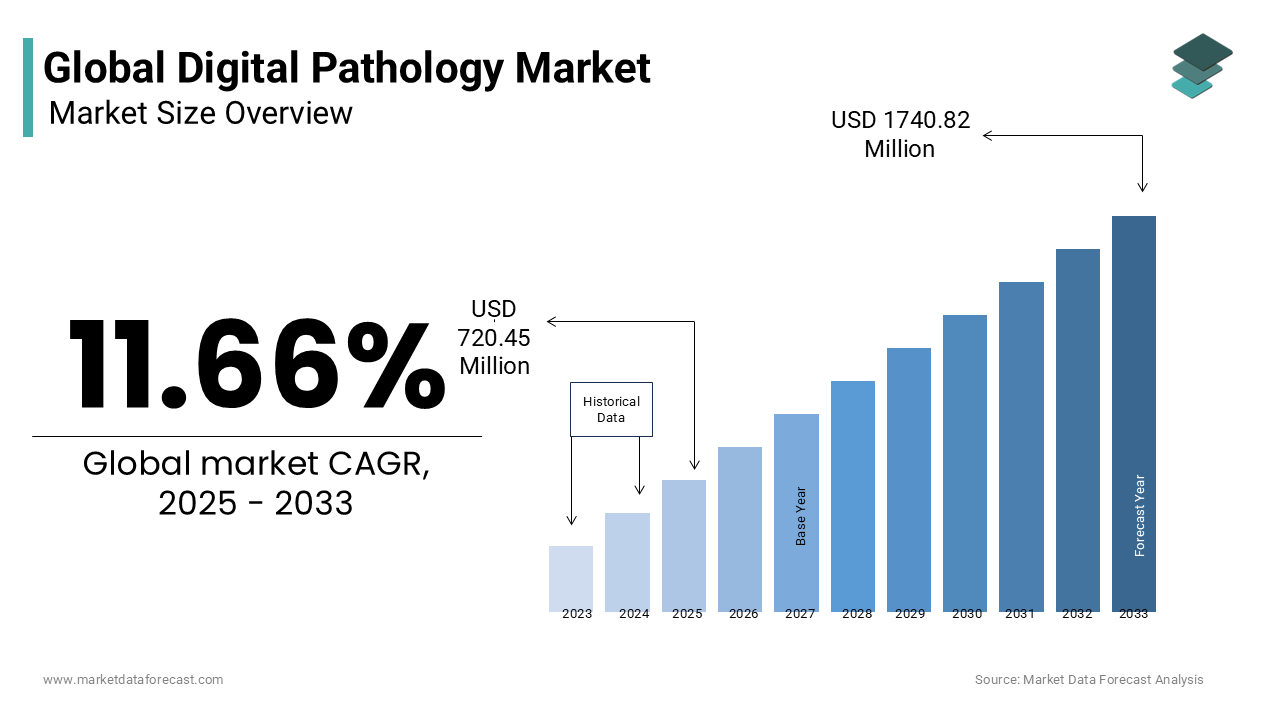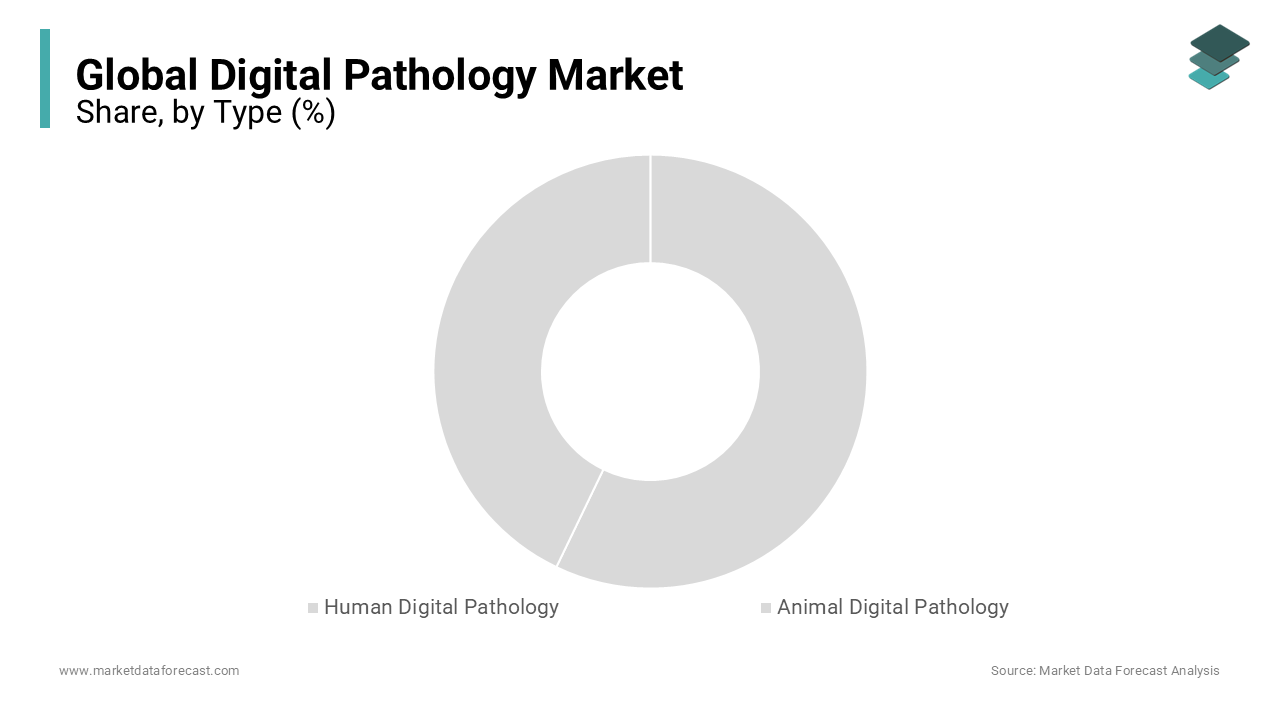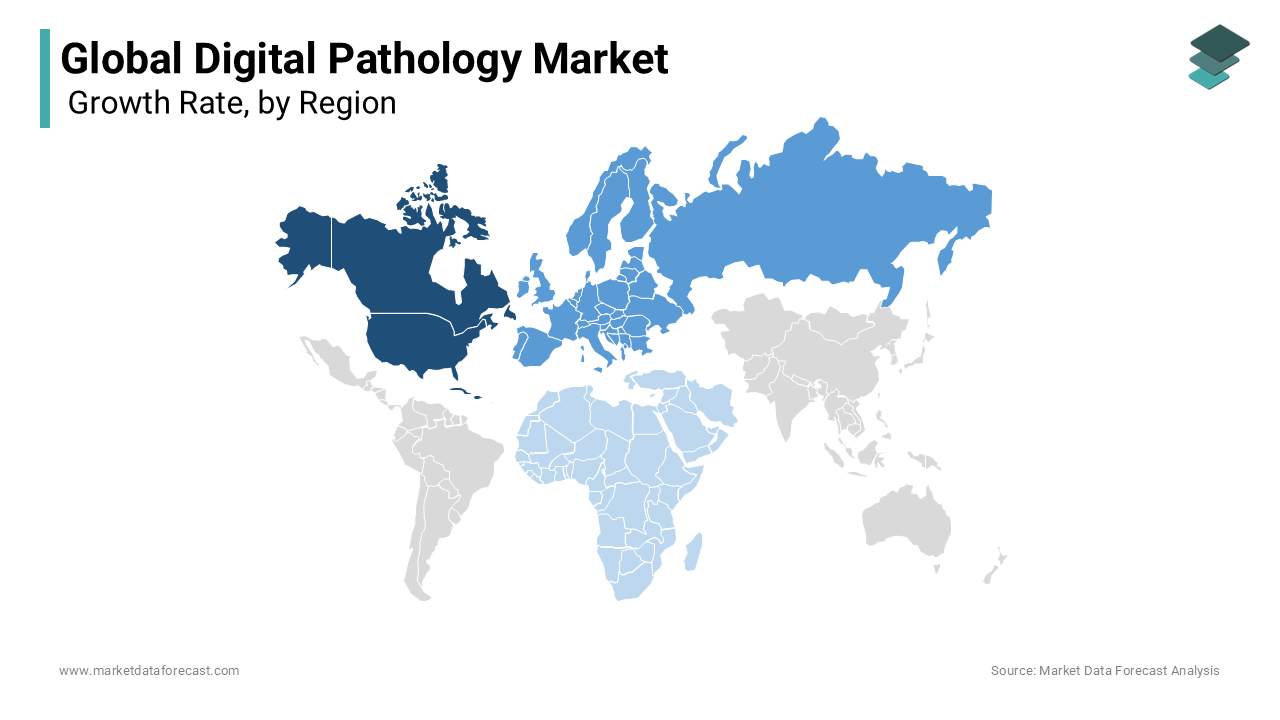Global Digital Pathology Market Size, Share, Trends & Growth Forecast Report - Segmented By Type (Human Digital Pathology & Animal Digital Pathology), Product (Scanners, Software, Communication Systems and Storage Systems), Application (Teleconsultation, Disease Diagnosis, Drug Discovery and Training and Education), End Users (Pharmaceutical and Biotechnology, Hospitals and Academic Institutes) and Region (North America, Europe, Asia Pacific, Latin America, and Middle East & Africa) - Industry Analysis From 2025 to 2033
Global Digital Pathology Market Size
As per our analysis report, the global digital pathology market is projected to value USD 1740.82 million by 2033 from USD 720.40 million in 2025, growing at a CAGR of 11.66% during the forecast period. The size of the digital pathology market was valued at USD 645.17 million in 2024.

Digital pathology includes managing, acquiring, sharing, and interpreting pathology information, including slides and data, in a digital environment. The central principle of digital pathology involves digitizing the sample with high-resolution images for analysis and storage. These images are sent to professionals for consultation. Digital pathology enables pathologists to engage, evaluate, and collaborate rapidly and remotely, improving efficiency and productivity. The global digital pathology market has witnessed prominent growth in the past years and is projected to have notable growth during the forecast period. Various advantages of digital pathology over the glass slides, such as improved analysis, reduced errors, and better views like zoomed and multiple-angle views, are majorly driving the market growth. The primary advantage of digital pathology is the quality of tests provided by this procedure, as it eliminates breakage and misidentification, which fuels the adoption rate in the healthcare industry. The escalating technological advancements in the healthcare and diagnostic industries are estimated to provide growth opportunities to the digital pathology market.
MARKET DRIVERS
The growing cancer patient population worldwide boosts the global digital pathology market growth.
According to the statistics published by the World Health Organization (WHO), approximately 10 million deaths happened due to cancer worldwide in 2020, which was the leading cause of death. The most common cancer types are breast, lung, prostate, colon, and rectum. The growing incidence of cancer is fuelling the need for accurate and efficient diagnostic procedures. The benefits that digital pathology offers such as faster slide scanning, improved image quality, and remote access to digital slides help significantly to help pathologists to make faster and more accurate diagnoses. The number of people diagnosed with cancer is growing significantly with each year passing and providing a way of a wealth of data for research and development efforts and driving innovation in the digital pathology field. The digital nature of pathology allows pathologists and healthcare professionals to connect regardless of their location and results in improved accuracy in diagnosis and treatment decisions. Likewise, the growing prevalence of cancer is anticipated to fuel the demand for digital pathology services and contribute to market growth.
Growing initiatives for the commercial exploitation of profitable digital pathology systems will likely provide service providers with growth opportunities during the forecast period. Governments are taking initiatives such as decreasing restrictions on digital pathology software and hardware approvals. For instance, in April 2020, the U.S. Food and Drug Administration issued a waiver allowing pathologists to perform primary readings from their homes and decreased restrictions on the approval of software and hardware. This resulted in an increased digital pathology implementation.
Technological advancements and the growing number of R&D activities in digital pathology further contribute to market growth. The rising focus on improving the workflow and demand for faster diagnostic tools for chronic diseases, the growing aging population and the rising chronic disease prevalence propel the growth of the global digital pathology market. The growing prevalence of promoting quality services for poor people, advanced technology such as digital imaging, computerization, robotic light microscopy, and multiple fiber optics communications further fuels the market’s growth rate. Furthermore, the increasing use of scanners in pathology labs and the launch of innovative products in the medical sector to promote better diagnostic procedures boost the growth rate of the digital pathology market.
MARKET RESTRAINTS
The high costs associated with the initial investment in digitizing histopathology slides are expensive, including the cost of scanners and software, which is expected to hamper the market growth due to restricted access for low and middle-income diagnostic organizations with limited budget issues. According to an NCBI article published in 2022, the list price of digital pathology scanners is around USD 100,000 to USD 400,000. Due to the enormous price, small and middle-sized pathology laboratories need help to afford whole slide images. There is a need for more trained and skilled pathologists as most pathologists have retired in recent years compared to several professionals joining the work. This acts as a restraining factor for the global digital pathology market expansion. According to Zippia, in 2021, the US had over 7,695 pathologists; 59.3% were women, while 40.7% were men. Another major factor is the security and privacy concerns due to digitalization as most patient data is stored online, which is highly prone to the risk of data breaches and authorization access, impeding the market growth rate. The presence of stringent regulations for approval of the procedures and the efficacy of the procedure by the regulatory authorities, which are complex and time-consuming, is challenging to the organizations.
REPORT COVERAGE
|
REPORT METRIC |
DETAILS |
|
Market Size Available |
2024 to 2033 |
|
Base Year |
2024 |
|
Forecast Period |
2025 to 2033 |
|
Segments Covered |
By Type, Product, Application, End-User, and Region |
|
Various Analyses Covered |
Global, Regional & Country Level Analysis, Segment-Level Analysis; DROC, PESTLE Analysis, Porter's Five Forces Analysis, Competitive Landscape, Analyst Overview of Investment Opportunities |
|
Regions Covered |
North America, Europe, APAC, Latin America, Middle East & Africa |
|
Market Leader Profiled |
Perkin Elmer, Inc., Definiens AG, Sectra AB, Koninklijke Philips N.V, G.E. Healthcare, Inspirata Co, Ventana Medical Systems, Inc., Leica Biosystems, 3D-Histech Ltd, Hamamatsu Photonics and K.K., Digipath Co. |
SEGMENTAL ANALYSIS
By Type Insights
Based on type, the human pathology segment is expected to hold the major share of the global market during the forecast period. The growing adoption of digital pathology solutions in healthcare institutions for enhanced diagnostics, research, and education, increasing number of advancements in imaging technologies, such as whole slide imaging, facilitating digital pathology implementation and growing demand for efficient storage, retrieval, and analysis of large volumes of pathology data majorly drive the growth of the human pathology segment in the global market. The rising need for remote collaboration and consultation among pathologists and the potential for improved accuracy, efficiency, and workflow optimization in pathology practices further boost the growth rate of the human segment in the worldwide market.

The animal segment is anticipated to witness a healthy CAGR during the forecast period. The growing veterinary healthcare industry, rising focus on animal health diagnostics, advancements in digital imaging and scanning technologies for veterinary pathology and growing demand for efficient storage, sharing, and analysis of animal pathology images and data propel the growth of the animal digital pathology segment in the worldwide market.
By Product Insights
Based on the product, the scanners segment is expected to occupy the most significant share of the global market during the forecast period. The growing adoption of digital pathology for efficient and accurate slide scanning and image acquisition and increasing demand for high-resolution scanners capable of capturing detailed pathology images drive the growth of the scanners segment in the global market. Advancements in scanner technology, such as faster scanning speeds and improved image quality, and the benefits of digitizing slides for archiving, remote consultation, and collaboration, further propel the segmental growth.
The software segment is anticipated to witness a healthy CAGR during the forecast period owing to the rising need for advanced image analysis and interpretation tools for pathology and features like image management, annotation, and reporting capabilities driving software adoption.
By Application Insights
Based on application, the teleconsultation segment is predicted to lead the global digital pathology market and is likely to grow further during the forecast period. The rising need for remote pathology consultations and expert opinions, advancements in telecommunication and connectivity technologies, the ability to access and share digital pathology images and data remotely and the cost-effectiveness and convenience of telepathology for healthcare providers support the growth of the teleconsultation segment in the global market.
The drug discovery segment is expected to register the fastest CAGR during the forecast due to the increased availability of funding for research and development. The growing usage of digital pathology in preclinical and clinical research for drug development and increasing adoption of digital analysis of tissue samples for target identification and biomarker discovery.
By End User Insights
The pharmaceutical and biotechnology segment leads the global market during the forecast period based on end-users. It is likely to grow further during the forecast period due to the implementation of digital pathology for biodiversity, biopharmaceutical studies, and molecular analysis.
REGIONAL ANALYSIS

Geographically, the North American digital pathology market is estimated to contribute the largest share to the global digital pathology market during the forecast period. This trend is expected to continue throughout the forecast period due to the increasing adoption of digital pathology systems. Technological advancements and early adoption of digital pathology solutions, rising demand for efficient diagnostic tools and improved patient care, strong healthcare infrastructure and government initiatives promoting digitalization and growing prevalence of chronic diseases and the need for accurate diagnostics propel the growth of the North American market. Highly developed North American countries such as the United States and Canada significantly boost this regional market and are the primary reason behind North America's leading spot.
The European digital pathology market had the second-largest share of the worldwide market in 2024 and is expected to grow at a healthy CAGR during the forecast period. The growing cancer incidence and increasing adoption of teleconsultations in Europe primarily drive the Europe digital pathology market. The growing focus on personalized medicine and precision diagnostics, rapid adoption of digital pathology for research and clinical applications, supportive government regulations and funding for digital healthcare and increasing number of collaborations between industry and academia for advancements in digital pathology fuels the growth rate of the European market. The U.K., followed by Germany is anticipated to hold the leading share of the European market during the forecast period.
The digital pathology market in the APAC is forecasted to grow at a high CAGR during the forecast period due to rising awareness of digital pathology systems, a vast patient pool with chronic and infectious diseases, and rising healthcare expenditure in the Asia-Pacific region. The rising awareness and adoption of digital pathology solutions, growing prevalence of chronic diseases and need for efficient diagnostics and large patient population and increasing demand for telepathology in remote areas further contribute to the APAC market growth.
The Latin American digital pathology market is expected to showcase a healthy CAGR during the forecast period. The growing investments in healthcare infrastructure and digitization and rising burden of infectious diseases and the need for accurate diagnostics propel the digital pathology market growth in Latin America. The growing initiatives from the governments of Latin American countries to improve access to healthcare services and rapid adoption of digital pathology for pathology education and training further boost the growth of the Latin American market. Brazil, followed by Mexico, is expected to play a vital role in this regional market.
The digital pathology market in MEA is yet to gain its full potential and is estimated to grow at a steady CAGR from 2025 to 2033.
KEY MARKET PLAYERS
Perkin Elmer, Inc., Definiens AG, Sectra AB, Koninklijke Philips N.V, G.E. Healthcare, Inspirata Co, Ventana Medical Systems, Inc., Leica Biosystems, 3D-Histech Ltd, Hamamatsu Photonics and K.K., and Digipath Co. are some of the major companies in the global digital pathology market.
RECENT HAPPENINGS IN THE DIGITAL PATHOLOGY MARKET
- In February 2024, F. Hoffman-La Roche Ltd announced a partnership with PathAI to develop artificial intelligence (AI) digital pathology algorithms for Roche’s Tissue Diagnostics business.
- In October 2023, Pramana and Gestalt announced the availability of an integrated AI-powered platform and digital pathology solutions, combining digital pathology, AI, image analysis, and DICOM into a streamlined, single, comprehensive offering.
- In October 2023, F. Hoffman-La Roche Ltd. announced its partnership with Ibex and Amazon Web Services to enhance the adoption of AI-enabled digital pathology solutions, which help diagnose breast and prostate cancer.
- In August 2023, PathAI announced the commercial launch of its product “AISight Digital Pathology Image Management System.”
- In 2023, Leica Biosystems announced the launch of its new digital pathology platform, the Aperio VERSA. The Aperio VERSA is a comprehensive digital pathology platform that offers a wide range of features, including whole-slide imaging, image analysis, and telepathology.
- In 2023, Roche Diagnostics launched its new digital pathology software, the NAVIFY Digital Pathology Platform. This cloud-based platform offers many features, including whole-slide imaging, image analysis, and telepathology.
- In 2022, Hamamatsu Photonics announced the launch of its new digital pathology scanner, the NanoZoomer S60. This high-speed scanner can scan whole slides in 15 seconds.
MARKET SEGMENTATION
This research report on the global digital pathology market has been segmented and sub-segmented based on the type, product, application, end-user, and region.
By Type
- Human Digital Pathology
- Animal Digital Pathology
By Product
- Scanners
- Software
- Communication Systems
- Storage Systems
By Application
- Teleconsultation
- Disease Diagnosis
- Drug Discovery
- Training and Education
By End Users
- Pharmaceutical and Biotechnology
- Hospitals
- Academic Institutes
By Region
- North America
- Europe
- Asia Pacific
- Latin America
- The Middle East and Africa
Frequently Asked Questions
Who are the major players in the digital pathology market?
Perkin Elmer, Inc., Definiens AG, Sectra AB, Koninklijke Philips N.V., GE Healthcare, Inspirata Co., Ventana Medical Systems, Inc., Leica Biosystems, 3D-Histech Ltd, Hamamatsu Photonics and K.K., and Digipath Co. are a few of the companies playing a leading role in the global digital pathology market.
Does this report include the impact of COVID-19 on the digital pathology market?
Yes, we have included the impact of COVID-19 on the global digital pathology market in this report.
Which region will lead the digital pathology market in the future?
The global digital pathology market size is estimated to grow by USD 1740.82 million by 2033.
Related Reports
Access the study in MULTIPLE FORMATS
Purchase options starting from $ 2500
Didn’t find what you’re looking for?
TALK TO OUR ANALYST TEAM
Need something within your budget?
NO WORRIES! WE GOT YOU COVERED!
Call us on: +1 888 702 9696 (U.S Toll Free)
Write to us: [email protected]
